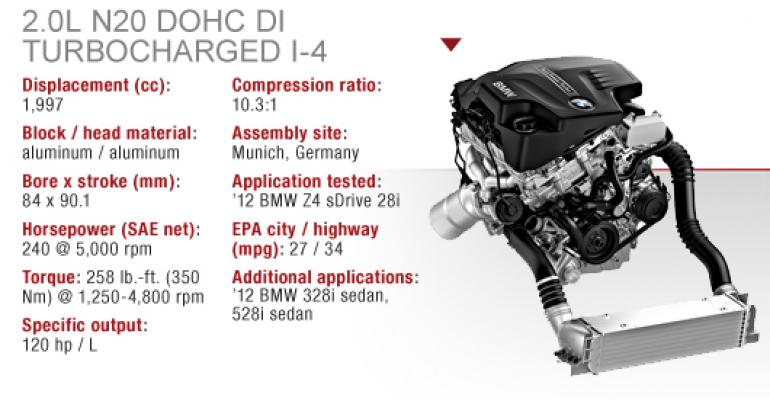For years, BMW buyers managed to close their purchases without heavy lifting when deciding which engine to choose: The coveted inline 6-cyl. always was a safe bet, whether naturally aspirated or turbocharged, a brilliant example of refined power.
That decision becomes more difficult as the German auto maker returns with its first 4-cyl. engine for the U.S. market in 12 years. This all-new N20 I-4 is rolling out globally and promises to become a cornerstone for the brand as it adjusts to meet stricter fuel-economy mandates.
For its breathtaking ability to propel both the Z4 roadster and 528i sedan with thrilling efficiency, the N20 earns a 2012 Ward’s 10 Best Engines trophy by proving once and for all that engine downsizing can be a movement to embrace, rather than dread.
Everyone’s working on cutting-edge 4-cyl. engines these days, even Porsche. And Mercedes brings a 1.8L turbocharged 4-cyl. to the U.S. in the C250 that isn’t too shabby.
If Germany’s finest auto makers can uphold their brands’ driving characteristics and deliver an intoxicating exhaust note with as few as four pistons, why wouldn’t car buffs celebrate this advancement?
Sure, old habits die hard, but many of the technologies that make BMW I-6s so delicious are deployed in the 120 hp/L N20, such as the sophisticated Valvetronic variable-intake valve-lift system that regulates how much air the engine needs and minimizes pumping losses.
And the TwinPower name used for BMW’s excellent N55 I-6 – another 2012 Ward’s 10 Best Engines winner – also applies to the new N20 I-4: Both engines pair high-pressure direct injection and the Valvetronic intake control with an efficient single twin-scroll turbocharger.
As we reported previously about this engine, fuel injectors are centrally positioned between the valves, spraying a fine high-octane mist into the combustion chamber at a pressure of 2,900 psi (200 bar).
The injected fuel creates a cooling effect that allows for further efficiency improvements and a higher compression ratio of 10.3:1.
Exhaust gases leave the engine two cylinders at a time, and each stream is kept completely separate as they flow through the exhaust manifold, taking a spiral path to the turbine wheel.
BMW opts for this design to minimize exhaust backpressure at low engine speed and maximize rotation of the turbine blades, meaning quicker engine response. As for turbo lag, there is none.
WardsAutoeditors logged 560 miles (901 km) in the Z4 sDrive 28i and 430 miles (692 km) in the heavier and more practical 4-door 528i and managed to top 27 mpg (8.7 L/100 km) in our evaluations.
For BMW to test the 4-cyl. waters in these vehicles takes courage. The safer bet would have been the entry-level 1-Series. But no, even a sexy roadster with a base price close to $50,000 can get all the motivation it needs from the N20 and sound great doing so.
The same is true for the 5-Series, which becomes more affordable now with the N20 and a base price well below the $55,000 10 Best Engines price cap.
This engine will be even more affordable when it arrives in the all-new 3-Series in early 2012.
To believe a BMW is worthy of its blue-and-white roundel only if an inline-6 is under the hood is a bit like medieval scholars claiming the world is flat.
Sail on into the future, Bavaria.





